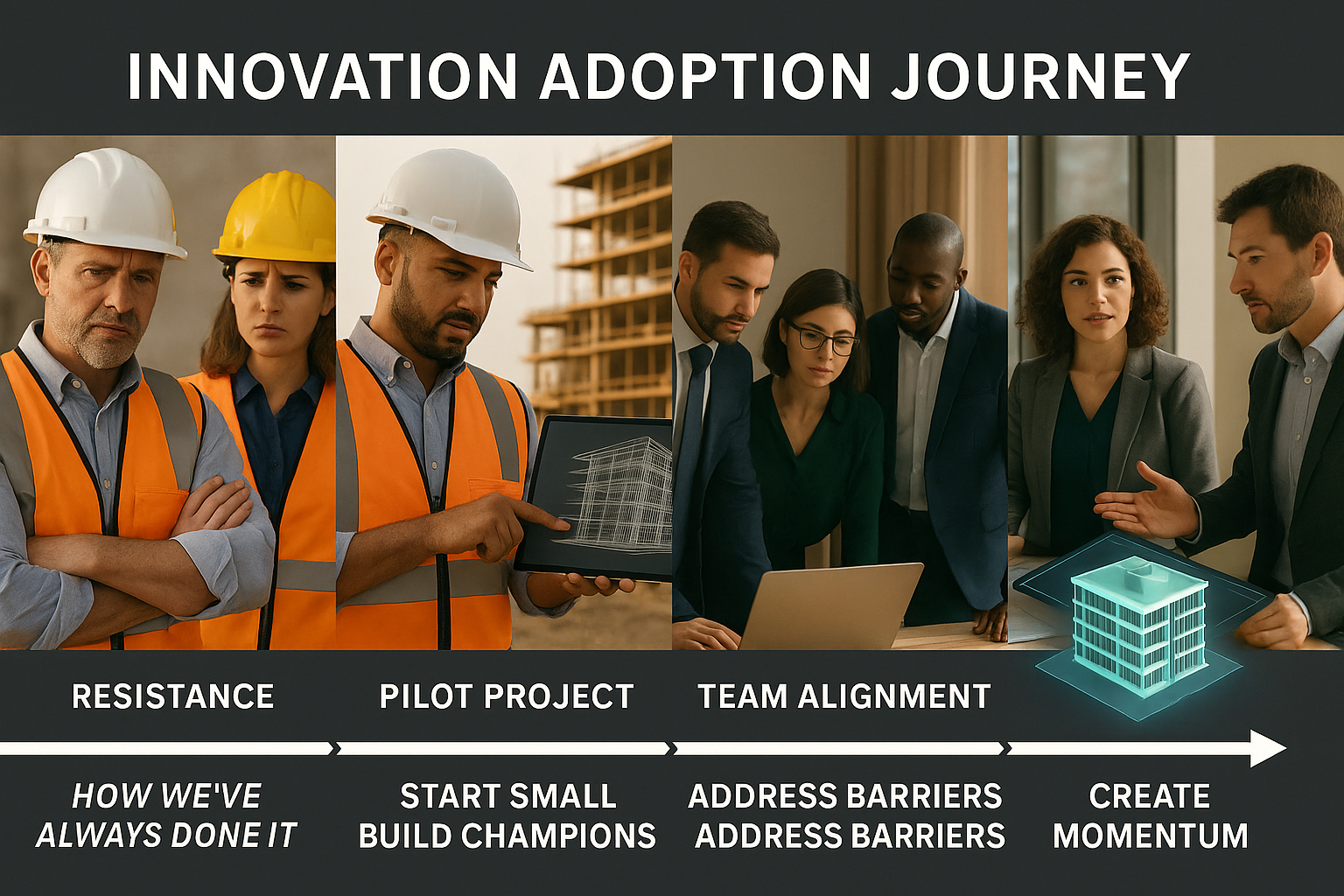Anyone trying to introduce new technology in construction knows the struggle. You’ve identified a solution that could save time, reduce costs, or improve quality, yet getting people to adopt it feels like pushing a boulder uphill. Even obviously beneficial innovations can take years to gain acceptance. The familiar refrain is always the same: “This is how we’ve always done things.”
This resistance isn’t unique to construction, but it’s particularly pronounced in an industry built on established practices, strict regulations, and deep-rooted traditions. Recent research examining AI implementation in construction reveals why innovation faces such stubborn opposition—and what actually works to overcome it.
The Three Pillars of Resistance
Construction operates within what researchers call “institutional pillars”—invisible but powerful forces that shape how people think, behave, and make decisions. Understanding these three barriers is crucial for anyone trying to drive meaningful change.
Regulatory Barriers: The Rules That Bind: The most visible obstacle to innovation is the complex web of building codes, safety regulations, labor agreements, and legal requirements that govern construction. These rules exist for good reasons—they protect public safety, ensure worker rights, and maintain quality standards. However, they can also create significant roadblocks.
Consider prefabricated construction technologies that could dramatically reduce project timelines and improve quality. Many innovative prefab companies have spent years navigating approval processes, conducting extensive testing, and working with regulatory bodies to gain acceptance for new building methods. The regulatory framework, designed for traditional construction approaches, doesn’t easily accommodate new technologies.
Similarly, drone technology for site inspections faced years of regulatory hurdles before becoming widely accepted. Early adopters had to work through aviation regulations, insurance requirements, and safety protocols that hadn’t anticipated this use case. While these regulations eventually adapted, the process created significant delays and costs.
Cultural Norms: The Unwritten Rules: Perhaps more challenging than formal regulations are the informal norms that define “how things should be done” in construction. These unwritten rules shape professional identities, define acceptable risk levels, and establish expectations about roles and responsibilities.
In construction, cultural norms run deep. Many professionals take pride in “tried and true” methods that have worked for decades. There’s wisdom in this approach—construction mistakes can be costly and dangerous. However, this same conservatism can make teams hesitant to try new approaches, even when they offer clear benefits.
Collaborative project delivery methods like Integrated Project Delivery (IPD) provide a perfect example. IPD has demonstrated significant benefits in terms of cost, schedule, and quality across numerous projects. Yet adoption remains limited because IPD requires fundamental changes to how teams interact, share risk, and make decisions. These changes challenge established norms about professional boundaries, liability allocation, and project control.
The “not invented here” syndrome is another manifestation of cultural resistance. Teams may reject innovations developed by other disciplines or industries, preferring solutions that emerge from within their own professional community.
Professional Identity: Tribal Boundaries: The third source of resistance comes from the strong professional identities that define different construction disciplines. Architects, engineers, contractors, and subcontractors don’t just have different roles—they often have distinctly different cultures, values, and ways of thinking about problems.
These professional identities create both strengths and challenges for innovation. They ensure specialized expertise and maintain quality standards within disciplines. However, they can also create communication barriers and resistance to innovations that blur traditional professional boundaries.
Building Information Modeling (BIM) illustrates this challenge perfectly. BIM requires unprecedented collaboration between architects, engineers, and contractors. Early adoption was slowed not just by technology challenges, but by cultural resistance to sharing information and making decisions collaboratively rather than sequentially. Each discipline had to overcome concerns about losing control over their traditional areas of expertise.
Beyond the Three Pillars
While these three pillars explain much about innovation resistance, other factors also play crucial roles in determining whether new technologies succeed or fail.
Business Model Conflicts: One of the most powerful but overlooked sources of resistance is the mismatch between innovations and existing business models. If a company bills clients by the hour, technologies that dramatically reduce the time required for tasks may not be economically attractive, even if they improve quality or reduce errors. This creates a paradox where innovations that benefit the overall project may actually harm the financial interests of specific companies.
Client Expectations: Construction companies often follow rather than lead their clients when it comes to innovation. If clients don’t request or value new technologies, companies have little incentive to invest in them. This creates a cycle where adoption waits for demand, but demand won’t emerge until adoption demonstrates clear benefits.
Supply Chain Readiness: Many construction innovations require coordinated adoption across multiple companies and disciplines. A contractor might be ready to adopt new technologies, but if subcontractors, suppliers, or design teams aren’t prepared to support them, implementation becomes difficult or impossible.
Strategies That Actually Work
Understanding the sources of resistance provides insights into more effective strategies for driving innovation adoption.
Start Small and Prove Value: Rather than attempting industry-wide transformation immediately, successful innovation often begins with small-scale pilots that demonstrate clear value. These “proof of concept” projects allow teams to experiment with new approaches while limiting risk and building confidence.
Effective pilots focus on specific problems where the innovation provides obvious benefits. For example, rather than implementing comprehensive AI systems across all operations, a company might start by using AI for specific tasks like invoice processing or schedule optimization where benefits are easily measured and understood.
Build Coalitions and Champions: Innovation rarely succeeds through individual effort alone. The most effective change strategies involve building coalitions of supporters who can advocate for new approaches from different perspectives and organizational levels.
These coalitions should include both formal leaders with decision-making authority and informal influencers who shape opinions and culture. Having champions at multiple levels—from field supervisors to executives—creates momentum that’s difficult to resist.
Successful innovation champions understand that their role extends beyond technical implementation to include education, relationship-building, and cultural change management.
Address All Barriers Simultaneously: The most sustainable innovations address regulatory, cultural, and identity concerns simultaneously rather than focusing solely on technical capabilities. For regulatory challenges, this might involve working with code officials early in the development process. For cultural resistance, it means demonstrating how innovations align with existing values. For identity concerns, it involves showing how new technologies enhance rather than threaten professional capabilities.
Create Protected Spaces for Experimentation: One effective strategy is creating “innovation sandboxes”—protected environments where teams can experiment with new approaches without the full pressure of project delivery requirements. These might be dedicated research projects, internal innovation labs, or partnerships with academic institutions.
Leverage External Pressure and Opportunities: Sometimes the most effective catalyst for innovation adoption is external pressure that makes change necessary rather than optional. This might come from regulatory requirements, client demands, competitive pressure, or market opportunities. Smart innovators watch for these external catalysts and position their solutions to address newly urgent needs.
Signs of Accelerating Change
Despite persistent resistance, several factors suggest construction innovation may be accelerating:
Generational Shifts: Younger professionals entering the industry often have different expectations about technology use and collaboration. As they advance into leadership positions, they bring more openness to innovation.
External Disruption: Companies from other industries—particularly technology firms—are entering construction with different approaches and fewer institutional constraints. Their success is creating pressure for traditional companies to innovate.
Economic Pressures: Margin pressure, labor shortages, and project complexity are creating urgent needs that traditional approaches struggle to address. This is making teams more willing to consider new solutions.
Technology Maturation: Many construction technologies are reaching maturity levels where they’re easier to implement and provide more reliable benefits. This reduces the risk and uncertainty that previously limited adoption.
The AI Test Case
Artificial intelligence presents an interesting test case for construction innovation. Unlike many previous technologies that required industry-specific development, AI capabilities developed for other industries can often be adapted for construction use relatively quickly.
AI has also achieved rapid mainstream acceptance in other sectors, creating familiarity and expectations that may reduce resistance. However, construction’s institutional pillars remain strong, and AI implementations still face the same fundamental challenges as other innovations.
Moving Forward
For construction professionals ready to drive innovation in their organizations, success requires understanding that resistance runs deeper than simple reluctance to change. The regulatory, cultural, and identity forces that create resistance are powerful, but they’re not insurmountable.
The key is developing strategies that acknowledge these deep sources of resistance while systematically addressing them through relationship-building, clear communication, and strategic patience. Innovation in construction typically takes years, not months, but the organizations that master this process will find themselves with significant competitive advantages as industry pressures for better productivity, sustainability, and quality continue mounting.
The path isn’t easy, but understanding why construction resists innovation provides a roadmap for more effective change strategies.









Leave a Reply